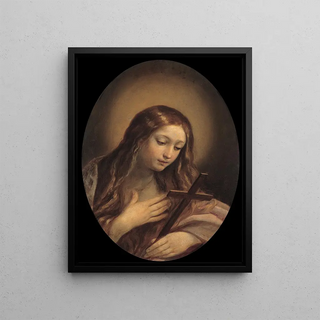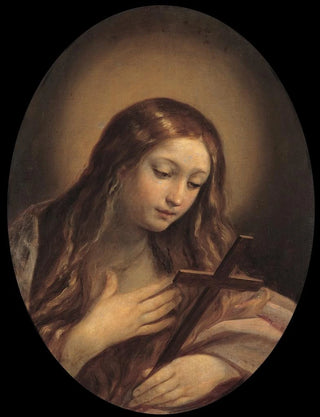Art print | Madeleine pénitente - Guido Reni


View from behind

Frame (optional)
Art print Madeleine pénitente - Guido Reni – Engaging Introduction
In the rich and intricate universe of baroque art, the "Madeleine pénitente" by Guido Reni stands as an iconic example of emotional depth and spiritual beauty. This painting, depicting Mary Magdalene in a moment of reflection and repentance, transcends mere artistic expression to become a true exploration of the human condition. Through her melancholic gaze and delicate posture, Reni captures a universal essence of redemption, inviting the viewer to introspective contemplation. The soft light illuminating her face and the subtle nuances of color contribute to creating an atmosphere that is both soothing and unsettling, where the sacred and the profane meet.
Style and uniqueness of the work
Guido Reni's work is distinguished by unparalleled mastery of light and shadow, a central element in "Madeleine pénitente." The contrast between deep shadows and luminous areas highlights the delicate features of the protagonist, emphasizing her expression of pain and serenity. The carefully balanced composition guides the viewer's gaze toward Madeleine's face, the true focal point of the scene. The rich, flowing drapery surrounding the figure adds a tactile dimension to the piece, revealing Reni's skill in depicting fabric textures while maintaining an airy lightness. This attention to detail and chromatic harmony make this painting a masterpiece that transcends time, inviting each viewer to reflect on themes of suffering and redemption.
The artist and his influence
Guido Reni, a prominent figure of 17th-century Italy, established himself as one of the masters of baroque through his unique approach to painting. Trained at the Bologna school, he integrated influences from Caravaggio while developing a personal style marked by elegance and softness. His works, often populated with angelic figures and religious scenes, demonstrate a deep understanding of human anatomy and poetic sensitivity. Reni inspired many artists of his time and subsequent generations, consolidating his legacy in

Matte finish

View from behind

Frame (optional)
Art print Madeleine pénitente - Guido Reni – Engaging Introduction
In the rich and intricate universe of baroque art, the "Madeleine pénitente" by Guido Reni stands as an iconic example of emotional depth and spiritual beauty. This painting, depicting Mary Magdalene in a moment of reflection and repentance, transcends mere artistic expression to become a true exploration of the human condition. Through her melancholic gaze and delicate posture, Reni captures a universal essence of redemption, inviting the viewer to introspective contemplation. The soft light illuminating her face and the subtle nuances of color contribute to creating an atmosphere that is both soothing and unsettling, where the sacred and the profane meet.
Style and uniqueness of the work
Guido Reni's work is distinguished by unparalleled mastery of light and shadow, a central element in "Madeleine pénitente." The contrast between deep shadows and luminous areas highlights the delicate features of the protagonist, emphasizing her expression of pain and serenity. The carefully balanced composition guides the viewer's gaze toward Madeleine's face, the true focal point of the scene. The rich, flowing drapery surrounding the figure adds a tactile dimension to the piece, revealing Reni's skill in depicting fabric textures while maintaining an airy lightness. This attention to detail and chromatic harmony make this painting a masterpiece that transcends time, inviting each viewer to reflect on themes of suffering and redemption.
The artist and his influence
Guido Reni, a prominent figure of 17th-century Italy, established himself as one of the masters of baroque through his unique approach to painting. Trained at the Bologna school, he integrated influences from Caravaggio while developing a personal style marked by elegance and softness. His works, often populated with angelic figures and religious scenes, demonstrate a deep understanding of human anatomy and poetic sensitivity. Reni inspired many artists of his time and subsequent generations, consolidating his legacy in






